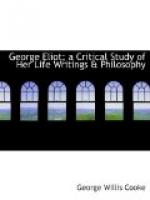such cockney sentimentality as this as an education
for the taste and sympathies, we prefer the most
crapulous group of boors that Teniers ever painted.
But even those among our painters who aim at giving
the rustic type of features, who are far above
the effeminate feebleness of the “Keepsake”
style, treat their subjects under the influence
of traditions and prepossessions rather than of
direct observation. The notion that peasants
are joyous, that the typical moment to represent a
man in a smock-frock is when he is cracking a
joke and showing a row of sound teeth, that cottage
matrons are usually buxom, and village children necessarily
rosy and merry, are prejudices difficult to dislodge
from the artistic mind, which looks for its subjects
into literature instead of life. The painter
is still under the influence of idyllic literature,
which has always expressed the imagination of the
cultivated and town-bred, rather than the truth
of rustic life. Idyllic ploughmen are jocund
when they drive their team afield; idyllic shepherds
make bashful love under hawthorn bushes; idyllic villagers
dance in the chequered shade, and refresh themselves,
not immoderately, with spicy nut-brown ale.
But no one who has seen much of actual ploughmen
thinks them jocund; no one who is well acquainted with
the English peasantry can pronounce them merry.
The slow gaze, in which no sense of beauty beams,
no humor twinkles,-the slow utterance and the heavy
slouching walk, remind one rather of that melancholy
animal, the camel, than of the sturdy countryman
with striped stockings, red waist coat and hat
aside, who represents the traditional English peasant.
Observe a company of haymakers, when you see them
at a distance, tossing up the forkfuls of hay
in the golden light, while the wagon creeps—slowly
with its increasing burthen over the meadow, and the
bright green space which tells of work done gets
larger and larger, you pronounce the scene “smiling,”
and you think that these companions in labor must
be as bright and cheerful as the picture to which they
give animation. Approach nearer, and you
will certainly find that haymaking time is a time
of joking, especially it there are women among the
laborers; but the coarse laugh that bursts out
every now and then, and expresses the triumphant
taunt, is as far as possible from your idyllic conception
of idyllic merriment. That delicious effervescence
of the mind which we call fun has no equivalent
for the northern peasant, except tipsy revelry;
the only realm of fancy and imagination for the English
clown exists at the bottom of the third quart-pot.
The conventional countryman of the stage, who picks up pocket books and never looks into them, and who is too simple even to know that honesty has its opposite, represents the still lingering mistake that an unintelligible dialect is a guarantee for ingenuousness, and that slouching shoulders indicate an upright disposition. It is quite true that a thresher is likely to be innocent of any




